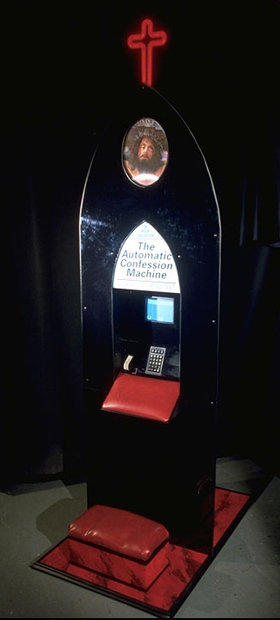Medium
Interactive computer based installation; wood, plexi-glass, leather, neon & fluorescent lights
Date
Intuition and Ingenuity
But what if God himself can be simulated, that is to say, reduced to the signs which attest to his existence?
–Jean Baudrillard, Simulations(1983)
This installation kiosk is a computerized confessional designed and fabricated to resemble an automatic banking machine. As with an ATM, the human computer interface (HCI) employs a simple alpha-numeric keypad and low resolution display. Human factors and religious ergonomics dictate the addition of a kneeler. A sinner’s spiritual accounting requires selections from a menu of the seven deadly sins and the Ten Commandments. Forgiveness is computed and the user receives appropriate penance as confirmation of the transaction.
First deployed in 1993, the Automatic Confession Machine: A Catholic Turing Test Release 6.0.1 retains the look and feel of the original graphical user interface, written in Hypercard. The ACM software is OSX compatible and is now available for the iPhone and iPad.
This work is inspired by memories of the Catholic Sacrament of Confession. The title also refers to the now famous test for judging if computers can think as proposed by Alan Turing in his essay titled: Computer Machinery and Intelligence, which appeared in the philosophical journal Mind in 1950. In this paper Turing replaces the question “Can machines think” with another question: “Are there imaginable digital computers which would do well in the imitation game?” This shrewd maneuver changes an intractable philosophical conundrum into a simpler problem of engineering and interface design.
The doubting Thomas kneeling at this automated confessional must make a digital leap of faith and surrender to the belief in the power of silicon absolution. Thus the user/sinner can experience the ecstasy of forgiveness in a Manichean system governed by the binary logic of good and evil where quilt, shame, sin, and salvation are all input variables that determine the catechism of output: namely how many Hail Marys and Our Fathers must be said for redemption. This artwork should not be misunderstood as an attack against religious faith. Rather this installation serves as a warning about the potential of technology to intrude into the most private and personal sphere of our being.
The human speaker will, contribute much to clothe ELIZA's responses in vestments of plausibility.
–Joseph Weizenbaum describing ELIZA(1966)
The Automatic Confession Machine has been exhibited nationally and internationally. Most recently the iPAD version (4.0) was part of the group show Intuition and Ingenuity commemorating the centenary of the birth of Allan Turing, author of the Turing Test for artificial intelligence. This traveling exhibition included the Victoria & Albert Museum in London and the Lighthouse in Brighton.
Hence, I have no doubt but that every one is absolved from his secret sins when he has made confession, privately before any brother.
–Martin Luther, Babylonian Captivity of the Church(1520)
